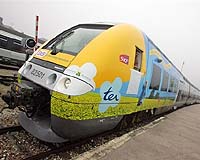 |
Edmonton, Canada (SPX) Jun 09, 2009 A University of Alberta researcher has devised a new theoretical approach to studying phantom traffic jams. Normally a traffic tie-up happens when vehicles reach a bottleneck and traffic flow is reduced, or in the case of an accident, halted completely. Phantom traffic jams are created by something as simple as a single driver tapping lightly on the brakes inadvertently starting a chain reaction of over-braking by drivers in the following vehicles. Eventually a long line of traffic comes to a complete stop. On major freeways in North America, phantom traffic jams can involve hundreds of vehicles and can snarl traffic for hours. U of A mechanical engineering professor Morris Flynn has revealed a new way to study the phenomenon. "We treat traffic as a chemically reacting gas," Flynn said. In the research team's eyes, traffic flow is a gas and the start of a traffic jam is an explosion and that force ripples outwards engulfing everything in its path. "Once a detonation wave begins, it keeps expanding outwards," added Flynn. "By the same token, a phantom traffic jam may start with only a handful of vehicles, but then quickly grow in scale and severity." Flynn and researches from the Massachusetts Institute of Technology created mathematical formulas to calculate the severity of phantom traffic jams for highways with various speed limits and traffic volumes. His research was published online this week in Physical Reviews E, which is published by the American Physical Society. Share This Article With Planet Earth
Related Links University of Alberta Car Technology at SpaceMart.com
 Think twice about 'green' transport, say scientists
Think twice about 'green' transport, say scientistsParis (AFP) June 8, 2009 You worry a lot about the environment and do everything you can to reduce your carbon footprint -- the emissions of greenhouse gases that drive dangerous climate change. So you always prefer to take the train or the bus rather than a plane, and avoid using a car whenever you can, faithful to the belief that this inflicts less harm to the planet. Well, there could be a nasty surprise in ... read more |
|
| The content herein, unless otherwise known to be public domain, are Copyright 1995-2009 - SpaceDaily. AFP and UPI Wire Stories are copyright Agence France-Presse and United Press International. ESA Portal Reports are copyright European Space Agency. All NASA sourced material is public domain. Additional copyrights may apply in whole or part to other bona fide parties. Advertising does not imply endorsement,agreement or approval of any opinions, statements or information provided by SpaceDaily on any Web page published or hosted by SpaceDaily. Privacy Statement |